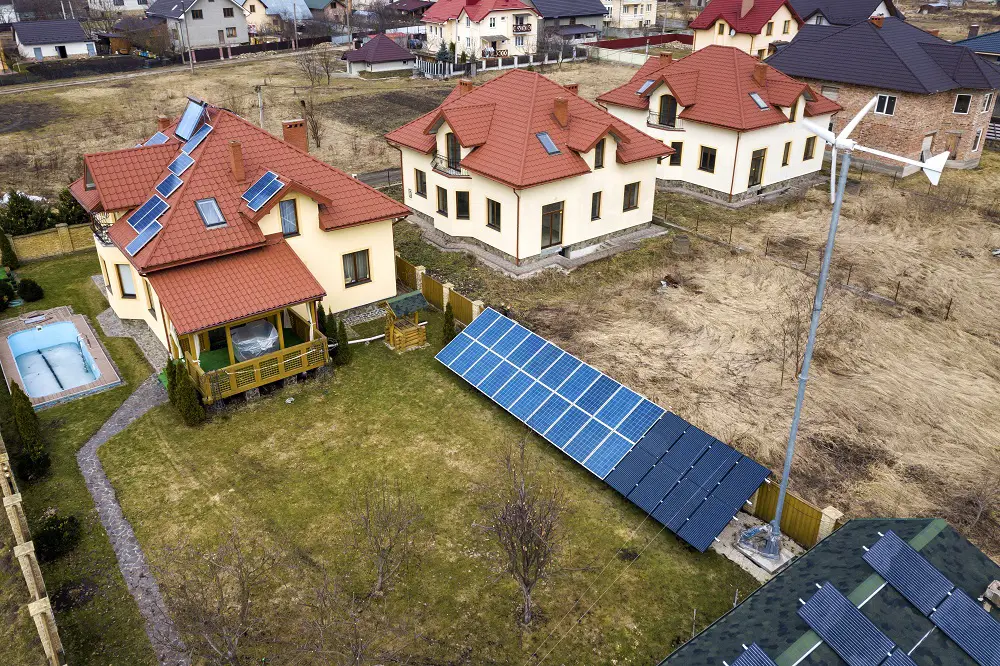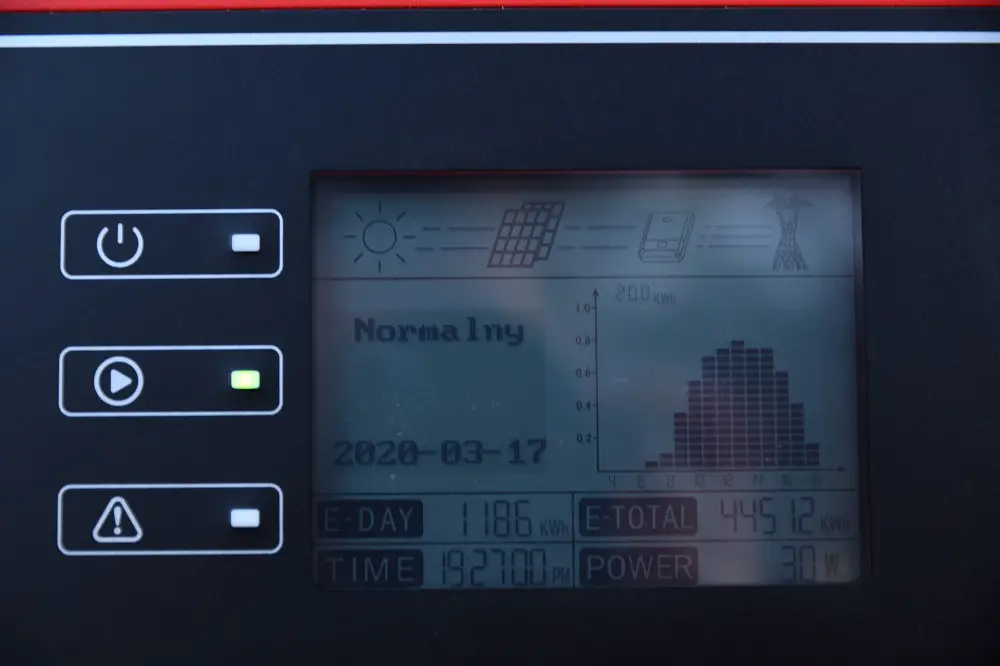For solar panels to work to their full potential, they should face directly into the sun.
It is a difficult feat to accomplish considering the sun constantly moves throughout the day; it also changes angles with each season.
To ensure maximum power generation from a system the correct solar panel angle and orientation is vital.
There are two angles to consider when setting up your array; elevation (tilt) angle and azimuth angle.
The former is a vertical angle and uses the latitude of your property. The latter is along the horizontal axis and configures in relation to the equator.
What is Solar Power?
A collection of photovoltaic cells gathered together beneath a glass layer are known as solar panels.
When attached to a roof, they react with photons from sunlight to generate clean, safe, reliable power. It is passed through an inverter and becomes usable electricity.
Facing solar panels directly towards the sun enables them to harvest the maximum amount of solar energy. There is a science to knowing the perfect solar panel angle, depending on where you live and the time of year.
Solar Power Angle

Elevation Angle
When building a solar power array, one of the first considerations is getting the best 'tilt' on each panel to receive the maximum amount of energy from the sun. This is achieved by setting the 'tilt' to be perpendicular to the sun.
The angle of the tilt will increase with latitude. Meaning, the further your house from the equator, the greater your tilt angle.
To illustrate:
- Little Rock, Arizona's Latitude: 32.289°
- Honolulu, Hawaii's Latitude: 21.307°
In these places the sun is higher in the sky meaning the tilt angle needs to be lower to capture direct sunlight.
Conversely:
- Saint Paul, Minnesota: 44.944°
- Salem, Oregon: 44.939°
In these places the sun is lower in the sky meaning the tilt needs to increase.
For the examples outlined below we will use Concord, New Hampshire, as our location.
Concord's latitude is 43.208°.
If your goal is optimize fixed-panels for year round production, you can use your location's latitude for the tilt.
Adjusting the Tilt Angle for Seasonal Differences

The sun sits higher or lower in the sky depending on the season. It is possible to adjust the system to suit your seasonal output requirements.
It's generally known that tilt angle is equal to the locations latitude minus 15 degrees in summer and plus 15 degrees in winter to an azimuth angle that is parallel to the equator(1).
In Concord, NH in Summer you would do 43.208° - 15° = 28.208°
In Concord, NH in Winter you would do 43.208° + 15° = 58.208°
Note: Most fixed-tilt solar PV systems feature a tilt angle between 20-30°.
For instance, if your energy demands increase during winter due to increased electrical heating, adjust the tilt of the panels +15°
If you rely heavily on expensive air-conditioning throughout the summer, a -15° adjustment increases power generation.
If you're conscientious and aim to get the maximum financial benefit from your solar array, adjust the tilt of each panel at the change of every season.
Azimuth Angle
If you're in the northern hemisphere, photovoltaic (PV) cells should always face south, though not where the compass points.
Magnetic forces from deep within the earth's core affect precise readings and only display magnetic-south. To calculate True South, you need to understand magnetic declination.
Magnetic Declination (Variation)
The difference between the angles of True North and magnetic-north might be as great as 25°. It states the number of degrees you need to compensate from the reading on a compass to achieve True North.
The direction of adjustment depends on where in the world you live.
For those in the Northern hemisphere:
If the magnetic declination (MD) is positive, east – adjust the array that number of degrees east.
If the magnetic declination is negative, west – adjust the array that many degrees west.
In the Southern hemisphere:
If the MD is positive, east – adjust west
If the MD is negative, west – adjust east.
To ascertain your state's magnetic declination, head to the NOAA.gov calculator. You should know the latitude and longitude, again, easily found online.
For example:
Concord, New Hampshire, has a 14.35°W magnetic variation. Face the solar array to the magnetic south and adjust 14° west to achieve True South and the perfect azimuth angle.
Cochran, Chile is in the southern hemisphere and has a magnetic variation of 11° east. Point the panels magnetic-north and adjust 11° west to achieve True North and the perfect azimuth angle.
The azimuth angle ensures solar panels point directly at the equator. Positioned to attract as much sunlight as possible, they maximize yield potential.
Does the Pitch of a Roof Affect Solar Production?
Comparisons between a shallow pitched roof at a 15° angle and a steep 45° angle result in little solar production difference.
The amount of power generated evens itself out across the seasons.
- Shallow Roof – Captures more of the sunlight during summer.
- Steep Roof – Captures more sunlight during winter.
If you intend to have a fixed system and not make seasonal adjustments, statistics prove that solar power at the optimal tilt angle is still a worthwhile investment.
Solar Trackers

A solar tracker is a device that automatically orients photovoltaic panels towards the sun. Each cell remains perpendicular to the sun, therefore, maximizing solar energy yield.
They offer a boost in the amount of energy that a solar array produces.
Single-axis solar trackers follow the sun as it rises and sets, resulting in increased performance of between 25-35%.
Dual-axis solar trackers follow daily patterns of the sun and track seasonal variations. This improves yield by 5-10% more than their single-axis counterparts.
Are Solar Trackers Worth it?
Most solar power systems don't come readily supplied with trackers for two reasons:
- They're expensive
- Most residential systems don't need them
If a system is installed south-facing, it is already oriented to capture maximum sunlight.
Fitting trackers costs between $600 - $1000 per panel
For that investment, expect to net an additional 60 – 90 watts per 300w panel.
In residential properties, it makes greater financial sense to add additional panels rather than fit expensive trackers; especially in 'sunny' states.
If there is no available space for extra panels and you need to increase the output provided by your solar array, trackers are an option.
Final Thoughts
The sun rises in the east and sets in the west, so you would be forgiven for thinking that pointing PV panels in the direction to harvest maximum sunlight would be easy.
But, due to the natural tilt of the earth and its elliptical orb, the sun's path across the sky differs.
To capture the best of the sunlight and maximize the yield of electricity production, apply the optimum solar panel angles, elevation and azimuth.
However, if constant adjustments seem too much trouble, installers consider your location and seasonal changes to design a fixed solar array that yields year-round best results.
References:

